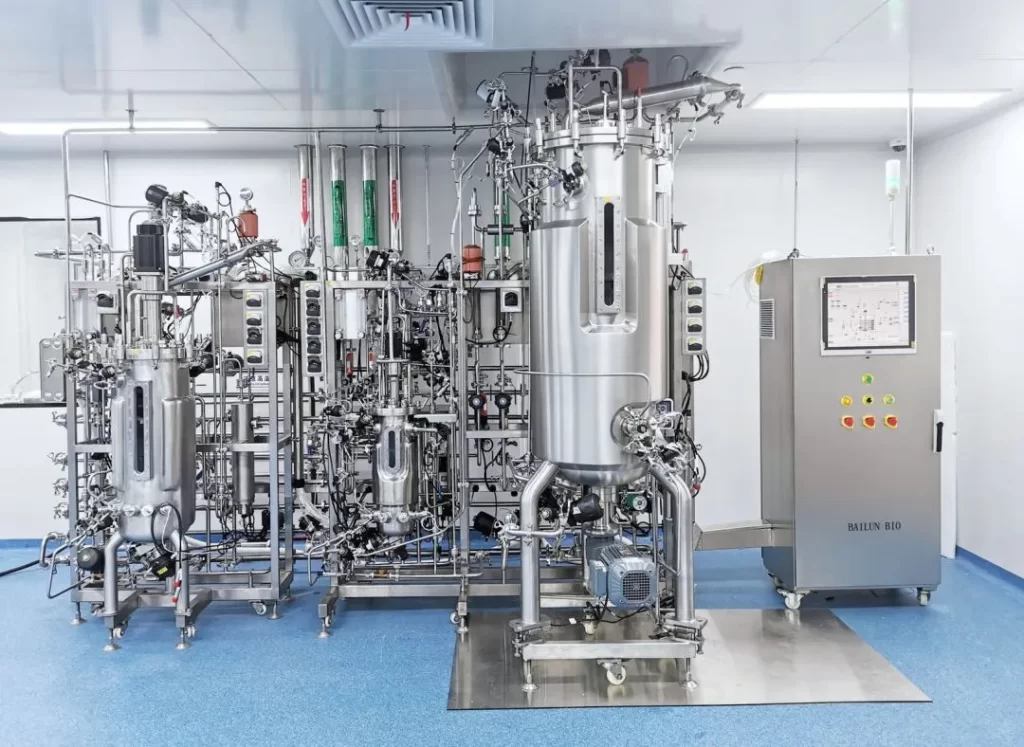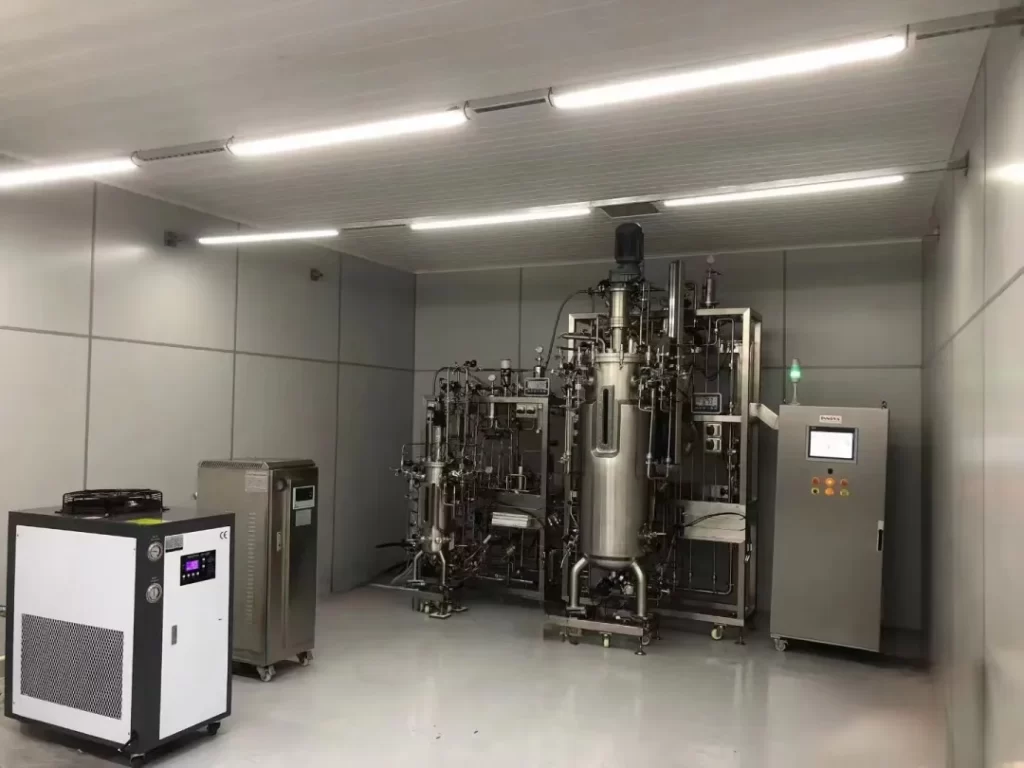Sensors are an important part of bioreactor process control, controlling temperature, pH, dissolved oxygen, and stirring speed. As bioreactor design and control advances, so do the requirements for sensing technology. For example, single-use bioreactors (SUB) are becoming more popular, and single-use solutions for pH and DO are also being introduced. However, most of the sensors currently used in SUBs are still used in traditional stainless steel bioreactors, which are not suitable for SUBs designs to some extent.
pH Sensor: Culture pH is a critical variable in bioreactor operation. pH sensing technologies can be broadly divided into the following categories: electrode-based porous glass electrolyte-filled sensors, and MOSFETs (Metal oxide semiconductor field effect transistor) based ISFET pH (Ion-sensitive field effect transistor). pH) sensors, pH sensors based on optical properties, potentiometric sensors, sensors with electrochemical sensing technology.

Glass pH electrodes are still widely used in the vast majority of pH sensors due to their superior repeatability, durability, and precise Nernstian responsiveness. Ion selective electrodes (ISE), such as electrochemical pH electrodes, are a large subcategory of sensors based on the potentiometric principle. Potentiometric is a method of measuring electric potential where there is no current between the electrodes. The indicator electrode compares the change in potential on the solid membrane between the internal solution analyte and the reference electrode. Current pH sensor designs typically incorporate a reference electrode inside the probe, resulting in a bulky structure. The main challenges of pH sensors with glass electrodes are the fragility of the glass material and the problem of fouling when used in complex media.
Electrochemical sensors use electrodes to convert analytes into measurable substances. For example, a gas sensor measures the concentration of a gas by oxidizing or reducing the target gas on the electrode and measures the generated current of the conversion. The electrochemical sensor consists of three electrodes: the working electrode, the reference electrode and the counter electrode. The working electrode undergoes a redox reaction with the ions. In addition to the electrodes, there is a breathable membrane inside the sensor to separate the water-based components from the gas, and the amount of gas reaching the working electrodes is adjusted to prevent leakage inside the sensor.
ISFET sensing technology uses field-effect transistors, which can be used to measure ion concentrations in solution because they are ion-sensitive. The source and ground electrodes are grounded to the substrate and connected to the circuit. The attachment of the analyte/ions to the grid membrane causes a change in the potential between the source and ground electrodes, which is a measure of the ion/analyte concentration. ISFETs are considered to be the first biosensor FETs for biological solutions, hence the same name as bioMOST transistors.
In contrast to electrochemical sensors, optical sensors only measureH3O+The activity of the ions. Optical sensors offer several advantages: small size, continuous measurement, no need for a separate reference electrode, etc. Photobleaching is the most important factor affecting the accuracy of this type of sensor. Cleavage of covalent or non-covalent bonds resulting from non-specific binding triggered by excitation light can lead to photobleaching of the indicator dye, making it unable to emit light. Resulting in inaccurate sensors over time. The main trend in the development of optical sensors is miniaturization. This will reduce costs and improve mass production. Optical pH patches are one such small optical sensor. Optical pH patches combine pH sensors onto adhesive discs attached to the surface of the bioreactor. Another recent area of research is the development of single-use optical sensors for use with single-use bioreactors.
Anaerobic processes rely heavily on “manual experimental analysis” and “qualified experimental operators”. The control measurements of the process involve spectroscopy, titration, etc. Currently, this type of biological process being studied requires different spectroscopic techniques due to the magnitude of the energy changes involved. Spectroscopy of biological processes often generates a large number of spectra, and the information content of each spectrum is significantly lower than the number of data, and it is key to quickly extract useful information from a large amount of data. Fluorescence spectroscopy appeared at the beginning of the twenty-first century. Fluorescence measurement in the reduced form of [NAD(P)H] is the most popular fluorescence sensor.
Temperature control in bioreactors is a well-established technology that can often achieve an accuracy of ±0.5°C or higher. Typical temperature sensors used in industry are thermocouples, resistance temperature detectors (RTDs), and thermistors. The choice of a specific temperature measuring instrument depends on the stability, sensitivity, accuracy, linearity, and sterilization of the sensor. PT100 is commonly used for temperature sensing in bioreactors. Platinum RTDs are used because they provide a near-linear response to temperature changes, are stable and accurate, provide a repeatable response, and they have a wide temperature range. RTDs are often used in precision applications because of their accuracy and repeatability. Temperature control in animal cell bioreactors is often simpler than in microbial fermenters because the cell culture is less metabolically active and requires less heat to be removed from the reactor.
Standard single-paddle impellers or single-baffle stirring tanks often have the disadvantage of uneven shear characteristics and energy dissipation. It has a great impact on susceptible microorganisms. In a multi-pitch impeller system, reducing the impeller speed to obtain equivalent power dissipation results in a reduction in the resulting maximum shear value. It should be noted that the shear force at the bubble interface is the same for both single-pitch and multi-pitch impellers. As a result, the overall rate of cell destruction due to fluid shear is expected to be lower in a multi-paddle impeller system that consumes the same total power. Therefore, when microorganisms are sensitive to shear, a multi-paddle impeller system will be preferred. During the installation of a paddle impeller, an instrument such as a tachometer is often used to detect that the required speed matches the readings in the tachometer to verify that the rpm value is close to the optimal value. CFD (Computational fluid dynamics) modeling and a mix of various characteristics are used to predict the desired impeller speed and control.
In addition to temperature, pH, DO and stirring speed, the online exhaust gas analyzer is also an important sensing technology for process control. Exhaust gas analyzers are commonly used in the composition analysis of VOCs or in the analysis of specific gases, and optical array sensing excels in the detection and identification of a wide range of analytes, including hazardous compounds, and can be used to detect and characterize VOCs collected in the headspace of a bioreactor. An exhaust gas analyzer with aCO2 sensor and a DO sensor that can be used to calculate OUR, which is also one of the key parameters for microbial growth. This analytical technique can be divided into non-invasive sensing techniques, which are used to detectCO2,O2 of the gas at the tail of the tank, analyze the respiratory quotient of metabolic processes, and monitor the process changes of fermentation. On-line monitoring can speed up the analysis without sampling, without pretreatment, directly connected to the fermenter exhaust pipe (traditional exhaust gas analyzers need to dehumidify the fermentation exhaust gas and other pretreatment), parallel bioreactors can choose multi-channel exhaust gas analyzers, such as four-channel, eight-channel, and dozens of channels. It is possible to monitor multiple tanks online and parallel at the same time.
About BaiLun Biotechnology Co., Ltd:
BaiLun Biotechnology Co., Ltd. stands as a leading supplier and premier technical service provider, specializing in the provision of comprehensive bioreactor systems and advanced control solutions. Our extensive product line encompasses a wide array of offerings, ranging from bioreactors (fermenters) to animal cell bioreactors, biological shakers, and control systems tailored for bioprocessing applications. With a capacity spanning from 0.1L to 1000KL, we are committed to fostering the growth of China’s bioreactor industry on a global scale.
At BaiLun, we boast a seasoned team of engineers equipped with profound expertise in fermentation processes, biochemical equipment, and chemical technology. Moreover, we actively engage nationally renowned experts and scholars as technical consultants, ensuring the robust technological underpinnings of our products. Central to our ethos is a relentless pursuit of product innovation and technological leadership, all geared towards guaranteeing utmost customer satisfaction. We hold ourselves accountable to prioritize customer benefits, embodying this commitment as the cornerstone of Bailun Company’s core values.
Our diverse product portfolio is meticulously crafted to cater to the multifaceted demands of our clientele. From inception, we have upheld the principles of quality paramountcy, customer-centricity, and integrity-driven operations. It is our unwavering dedication to meeting the evolving needs of our customers that propels us forward. Embracing the tide of economic globalization, we extend a genuine invitation to collaborate with enterprises worldwide, aiming for mutual prosperity and success.
The spirit of BaiLun encapsulates a dedication to customer-centricity, a pursuit of excellence in quality, a commitment to fairness and integrity, and an unwavering drive for continuous improvement and innovation.
Contact Us:
Add:6848# Liuxiang Rd., Jiading, Shanghai, China
Contact Person: Maddie
Email:[email protected]
Phone:+86-134-7276-8163 (WhatsApp)
Website: https://fermentorchina.com/


